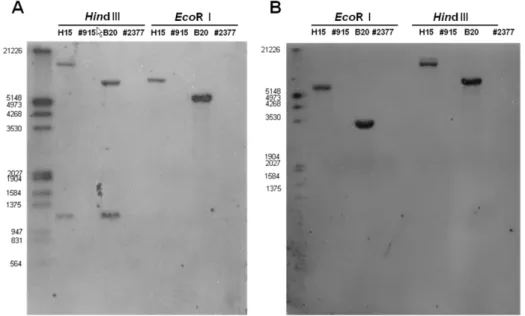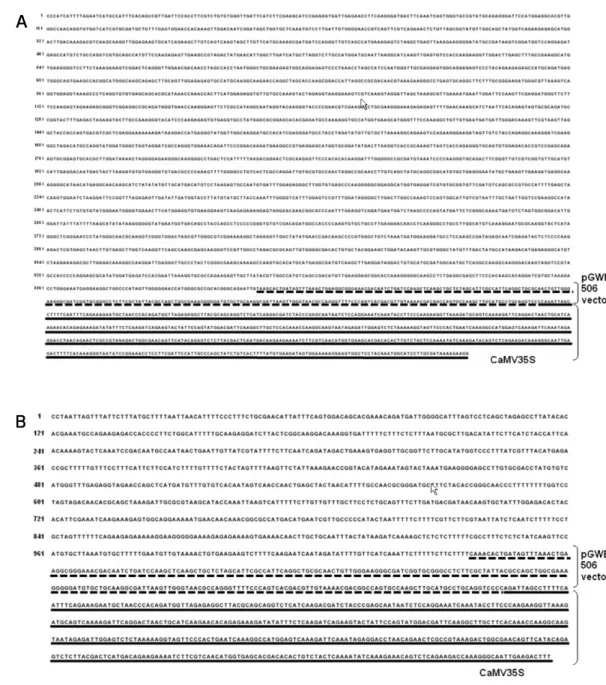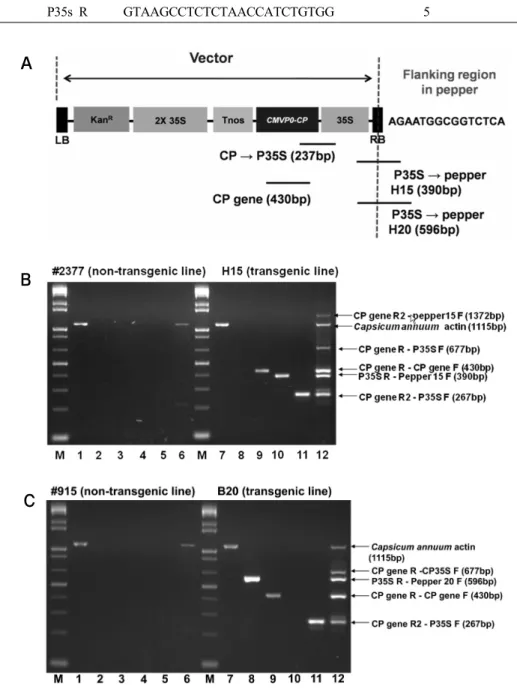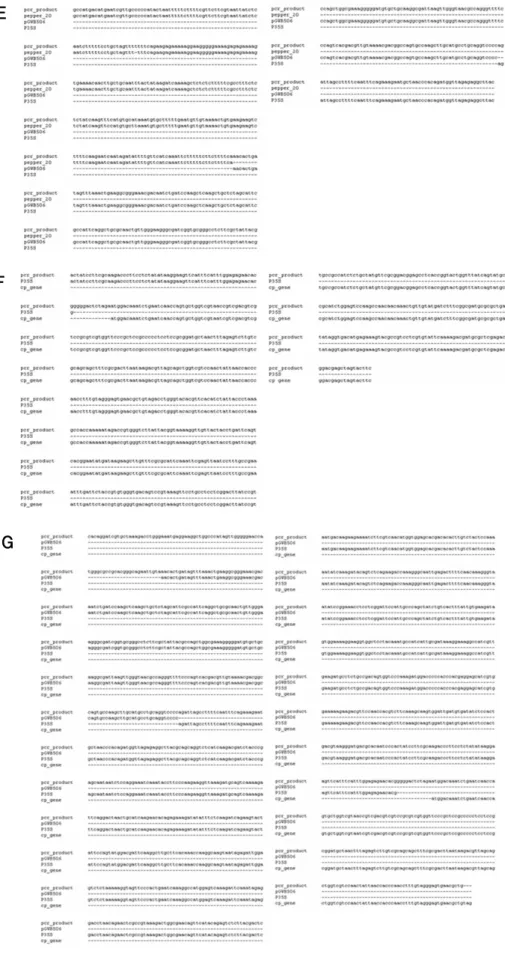S.-G. Seo and J.-S. Kim should be considered co-first authors.
S.-G. Seo ・ J.-S. Kim・ S.-B. Jeon ・ M.-R. Shin ・ S.-H. Kim ( ) (Department of Environmental Horticulture, The University of Seoul, Jeonnong-dong 90, Dongdaemun-gu, Seoul 130-743, South Korea)
e-mail: mongdal@uos.ac.kr S.-W. Kang ・ G.-P. Lee
(Department of Applied Plant Science, College of Industrial Science, Chung-Ang University, Anseong-Si, Gyeonggi-Do 456-756, South Korea)
J.-S. Hong ・ K.-H. Ryu
(Plant Virus Bank, Division of Environmental and Life Science, Seoul Women’s University, Seoul 139-774, South Korea) C.-H Harn
(Biotechnology Institute, Nongwoo Bio Co., Ltd, Yeoju, Gyeonggi, South Korea)
T.-S. Park
(Rural Development Administration, Suwon 441-707, Korea)
Characterization, detection and identification of transgenic chili pepper harboring coat protein gene that enhances resistance to cucumber mosaic virus
Sang-Gyu Seo ・ Ji-Seong Kim ・ Seo-Bum Jeon ・ Mi-Rae Shin ・ Seung-Won Kang ・ Gung-Pyo Lee ・ Jin-Sung Hong ・ Chee Hark Harn ・ Ki Hyun Ryu ・ Tae-Sung Park ・ Sun-Hyung Kim
Received: 28 October 2009 / Accepted: 18 November 2009
ⓒKorean Society for Plant Biotechnology
Abstract Previously, two events (H15 and B20) of transgenic pepper (Capsicum annuum L.) that enhanced resistance to Cucumber mosaic virus (CMV) by the introduction of CMV coat protein (CP) gene were constructed. Presently, a single copy number of the CP gene was revealed in H15 and B20 by Southern blot. To predict possible unintended effects due to transgene insertion in an endogenous gene, we carried out se- quencing of the 5’-flanking region of the CP gene and a Blast- based search. The results revealed that insertion of the trans- gene into genes encoding putative proteins may occur in the H15 and B20 transgenic event. Mutiplex polymerase chain reaction (PCR) for simultaneous detection and identification of transgenic pepper was conducted with a set of nine primers.
Both transgenic event were differentiated from non-transgenic
event by the presence of 267 bp and 430 bp PCR products indi- cative of CP gene specific primer pairs and primer pairs tar- geting the CP gene and 35S promoter. H15 and B20 uniquely possessed a 390 bp and 596 bp PCR product, respectively. The presence of a 1115 bp product corresponding to intrinsic pe- pper actin gene confirmed the use of pepper DNA as the PCR template. The primer set and PCR conditions used presently may allow the accurate and simple identification of CMV re- sistant transgenic pepper.
Keywords Capsicum annuum L., Cucumber mosaic virus, GMO, Multiplex PCR
Introduction
Since transgenic plants were first commercialized in 1997, their global use has progressively increased, exceeding 50- fold as of 2005. Transgenic soybean, maize, cotton and canola constitute almost 100% of the cultivated area of trans- genic crops, with the remainder being comprised of Bacillus thuringiensis rice and virus resistant squash and papaya (James et al. 2005). Since the introduction of transgenic crops, concern has been expressed about the consequences of the unintentional environmental introduction of transgenic genes.
Transgenic introduction of a gene can potentially influence the function of the surrounding sequence (insertion effect) or visa versa (position effect). The unintended effect of DNA in- sertion can be partly predicted on the basis of knowledge con- cerning the location and function of the inserted DNA (Kuiper et al. 2001).
DOI:10.5010/JPB.2009.36.4.384 Research Article
Multiplex polymerase chain reaction (PCR), which is perfor- med by use of a combination of several primer pairs in the same reaction tube, produces more information in a shorter time than single end point PCR with less consumption of rea- gents (Germini et al. 2004). Since its first description in 1988, this method has been successfully applied in many areas of DNA testing (Henegariu et al. 1997). Recently, several studies have exploited multiplex PCR for the efficient and reliable detection and/or identification of transgenic sugar beet shoots (Mannerliöf and Tenning 1997), and genetically modified varieties of maize (Matsuoka et al. 2001, James et al 2003), canola and soybean (James et al. 2003).
Previously, transgenic pepper eventtolerant to the new patho- type Cucumber mosaic virus CMVP1 was developed by ge- netic transformation of a coat protein (CP) gene from CMVP0 (Lee et al. 2009). The present study was undertaken to provide more information about newly developed transgenic pepper event. Specifically, we carried out DNA blot analysis to deter- mine the transgene copy number, performed sequencing of the flanking regions of the inserted DNA to predict unintended effects in transgenic event and used multiplex PCR to detect two transgenic event and also to identify each two event.
Materials and Methods DNA isolation
Genomic DNA was isolated from leaf tissues of the non-trans- genic event #2377 (parental eventof H15) and #915 (parental event of B20), and from the transgenic event H15 and B20 as previously described (Kim and Hamada 2005). Sample geno- mic DNA concentration was determined by measuring the ul- traviolet (UV) absorption at 260nm and purity was ascertained by measuring the absorbance due to protein at 280 nm and 230 nm, and calculating the A260/A280 and A260/A230 ratios.
All measurements utilized a Beckman DU 700 UV/vis spec- trophotometer (Beckman Instruments, Fullerton, CA) Southern blot analysis
Genomic DNA (30 g) was digested with EcoR and HindIII to cut the inserted CP gene. The resulting DNA fragments were separated by electrophoresis on a 0.8% agarose gel and there- solved fragments were transferred to a positive-charged nylon membrane (Roche Molecular Biochemicals, Mannhein, Germany) by capillary transfer using 0.4N NaOH. DNA pro- bes for the NPTII or CMV CP gene cDNA wereprepared from digoxigenin-PCR probe synthesis kit (Roche Molecular Bio- chemicals), Pre-hybridization, hybridization, and post-hybrid-
ization procedures were done according to the manufacturer’s instructions.
PCR-based genome walking
Genomewalking was performed using the protocol supplied by the vendor of the GenomeWalker Universal kit (Clontech Laboratories, Palo Alto, CA). Genomic DNA was digested with AluI, DraI, EcoRV, HpaI, PvuII and StuI, and was ligated with the GenomeWalker adaptor (Clontech Laboratories).
PCR were carried out using each enzyme-digested DNA library, 10 pM AP1 primer, 10 pM CP gene specific reverse primer, 0.2 mM dNTP mixture, 2.5 U of EX Taq polymerase (TaKaRa Shiga, Japan) and 10× EX Taq buffer (TaKaRa) in a 50 μl reaction volume using a xp thermal cycler (Bioer Tech- nology, Hangzhou, China). Cycling condition consisted of 5 cycles of 94℃ for 25 s and 72℃ for 3 min followed by 20 cycles of 94℃ for 25 s and 67℃ for 3 min, with a final cycle at 67℃ for 7 min. Semi-nested PCR was performed under the same conditions using 1/10 of the primary PCR product as DNA template and using the AP2 primer.
Multiplex PCR and sequencing of PCR product
Multiplex PCR reactions were carried out in thepresence of 40 ng of genomic DNA, 10 pM of the five primer pairs, 0.2 mM dNTP mixture, 1.5U of EX Taq polymerase and 10x EX Taq buffer in a 50 μl reaction volume. Thermal cycling was using the aforementioned xp thermal cycler at 94℃ for 3 min for predenaturation, 35 cycles of 94℃ for 30 s, 60℃ for 30 s and 72℃ for 1 min, with a final cycle at 72℃ for 5 min. The amplified PCR products were separated by electrophoresis on a 0.8% agarose gel. To identify optimal condition of multi- plex PCR, the concentration of each primer was adjusted de- pending on the linear range of PCR amplification prior con- ducted. Each PCR fragment was ligated into a T&A vector (Real Biotech, Taipei, Taiwan) and sequenced. The obtained sequence was aligned with vector and/or flanking region se- quence with the CLC Sequence Viewer 6.0.2 program (CLC bio, Katrinebjerg, Denmark) and the kalign program (http://
www.ebi.ac.uk/Tools/kalign/)
Results and Discussion Southern hybridization
DNA blot analyses were performed with probe derived from the CP gene and NPTII kanamycin resistant gene. When ge- nomic DNA digested with EcoRI and HindIII was hybridized
Fig. 1 Southern blot analysis of transgenic pepper and non-transgenic pepper. (A) Hybridization with coat protein specific probe. (B) Hybrization with NPTII gene for kanamycin resistance specific probe
with NPTII specific probe, a single band was evident in the H15 and B20 transgenic event, but no band was discernable in the parental event (Fig. 1). Hybridization with the CP gene specific probe also produced a single band when digested with EcoRI but two bands were apparent when digested with Hind III. This is explainable because the CP gene specific probe was made from full CP gene DNA sequence and the CP gene in the genomic DNA of transgenic plants contains one Hind III restriction site.
Flanking region and prediction of unintended effect
In Agrobacterium-mediated transformation, insertion of trans- ferred DNA with specific plant genomic DNA sequences oc- curs randomly and can produce unusual, insertion-related out- comes. The unusual changes of transgenic plants canbe de- tected by morphological and chemical analyses, although this approach can be onerous and is hindered by incomplete know- ledge of unknown plant traits or chemicals. Localization of insertion location is most direct approach to predicting and identifying the possible occurrence of unintended effects;
this can be achieved by direct sequencing of flanking DNA, despite the still-limited knowledge of plant genomes(Kuiper et al. 2001). The 5’-flanking sequence of the transgene in the H15 and B20 transgenic event were determined by PCR-based genome walking. Flanking sequences of about 3000 bp in H15 and 1000 bp in B20 were obtained. A 300 bp DNA flanking region adjacent to the vector region was used to determine the insertion site (Fig. 2). These processes were performed by searching known DNA sequences in an expressed sequence tag database using the BLAST algorithm. The search revealed
that the H15 transgene could be inserted into or adjacent to unidentified Capsicum annuum cDNA (Genebank accession no. GD102816 or CO907187). But, no significant similarity was found in a nucleotide database. The B20 transgene also was capable of similar insertions involving an ortholog in pe- pper of unidentified tomato or potato cDNA (Genebank acce- ssion nos. BG627797, CV505761, BG097242, or BI434579), and the insertion site displayed significant similarity with mRNA from root of Solanum lycopersicum. Thus, unintended effects are conceivable using the H15 and B20 event, and may be at least partly predictable based on knowledge of the inser- tion location, defined as a loss of function of the gene in the insertion region.
Multiplex PCR for detection and identification of transgenic plants
Detection of transgenic plants can be conducted by protein- based method such as Western blot and enzyme-linked im- munosorbant assay (ELISA), or DNA-based methods include- ing Southern blot and PCR (Ahmed 2002). Western and Southern blots and ELISA are highly specific but suffer from being comparatively time-consuming, costly and technical.
In contrast, the PCR-based approach, especially multiplex PCR, is a simple and sensitive means of distinguishing trans- genic plants (Yamaguchi et al. 2003). Multiplex PCR has been used to detect or identify three major transgenic crops: soy- bean (Roundup ready), maize (MON810, Bt11, event 176, T14/25 and GA21) canola (GT73, HCN92/28, MS8/RF3, Oxy235) (James et al. 2003, Margarit et al. 2005, Germini et al. 2004, Matsuoka et al. 2001, Yamaguchi et al. 2003).
A
B
Fig. 2 Sequence of 5΄-flanking region of transgene in the H15 (A) and B20 (B) transgenic pepper event
In this study, an efficient and simple detection and identifica- tion for virus tolerant pepper (Lee et al. 2009) was developed using the multiplex PCR system. Since efficiency of the amplification is affected by contamination of purified DNA (Hamill et al. 1991), purity of extracted genomic DNA was checked. Only high purity DNA, presenting A260/A280 and A260/A230 ratios exceeding 1.8 and 2.7, respectively, were used. Becausethe optimum condition for multiplex PCR appear to depend more on the primer combination (James et al. 2003), PCR reactions was conducted with five primer pairs (Table 1 and Fig. 3a) to verify the specificity of each primer pair. The concentration of each primer was adjusted depending on the linear range of PCR amplification. Five primer targets
vectors were used to differentiate transgenic eventfrom non- transgenic event. Especially, two specific sense primers, pep- per 15 F for H15 event and pepper 20 F for B20 event, which target the flanking region of each event, were used to identify the H15 and B20 event. Also, two specific primers for intrinsic pepper actin gene were used to confirm that the pepper DNA was used as the template for multiplex PCR.
In both the H15 and B20 event, CP gene R2 (antisense primer) targeted the CP gene and P35S F (sense primer) targeted the 35s promoter primer pairs, CP gene F and CP gene R primer pairs targeted the CP gene, and Pepper actin F and Pepper actin R primer pairs targeted the gene encoding actin, with the amp- lified PCR products being 267 bp, 430 bp, and 1115 bp respec-
Table 1 Sequence and concentration of primers and template DNA concentration for the multiplex PCR.
Template DNA (ng) Primer name Sequence (5'-3') Primer concentration (pmol) Product length (bp)
40
Actin F ATGGCAGATGAAGATATTCA 15
Actin R GCACTGTATGACTGACACCA 15 1115
CP gene F GTAGGGAGTGAACGCTGTAGACC 6
CP gene R GAAGTACTAGCTCGTCCGTCTCG 6 430
P35s F ACTATCCTTCGCAAGACCCTTC 14
CP gene R2 CTACAGCGTTCACTCCCTACAAAG 14 267
Pepper 15 F CACAGGATCGTGCTAAAGACCT 14
P35s R GTAAGCCTCTCTAACCATCTGTGG 5 390
Pepper 20 F GCCATGACATGAATCGTTGC 10
P35s R GTAAGCCTCTCTAACCATCTGTGG 5 596
A
B
C
Fig. 3 Multiplex PCR analysis. (A) Primer design for multiplex PCR. (B,C) Multiplex PCR detection and identification of two trans- genic peppers. Lanes: M, 1kb marker 1 and7, actin (1115 bp) 2 and 8, P35S-B20 flanking region (596 bp) 3 and 9, CP gene (430 bp) 4 and 10, P35S-H15 flanking region (390 bp) 5 and 11, CP gene-P35S (267bp) 6 and 12, multiplex PCR by a set of nine primers
A
B C
D
tively. But, in non-transgenic event, only the 1115 bp of PCR product appeared (Figs. 3). Additionally, a 390 bp PCR was apparent only from the DNA template of H15. In B20, a PCR product of 596 bp was apparent.
The CP gene R primer resulted in a 430 bp product with CP
gene F (expected) and 677 bp product with P35S-F (unex- pected) in both transgenic event, while the CP gene R2 primer resulted in a 1372 bp product with pepper 15 F (unexpected) product only in the H15 event. These results confirmed the specificity of two reverse primer targeting the CP gene se-
E
F
G
Fig. 4 Sequence comparison between PCR product and transgenic event harboring gene. (A) Actin (1115 bp). (B) CP gene (430 bp).
(C) CP gene – P35S (267 bp). (D) P35S-pepper 15 flanking region (390 bp). (E)P35S-pepper 20 flanking region (596 bp). (F) cp gene-P35S (677 bp). (G) Cp gene- pepper 15 flanking region (1372 bp)
quence and so the reliability of our results, and also reveal ano- ther difference between the H15 and B20 event.
Cloning and sequencing of each band fractionated by electro- phoresis was next performed. The sequence data confirmed that each band was due to primers used in this study, with each PCR product containing theproper sequence of vector and/or flanking sequence of the transgenic event (Fig. 4). Ideally, a multiplex PCR system capable of detecting transgenic plant targets like promoter and/or selection markers that is also cap- able of identifying specific event would be user-friendly and capable of simplifying the process of transgenic crop detection and identification (James et al. 2003). Also, the use of specific primer pairs targeting both the transgene and the flanking re- gion of each transgenic event provides reliability because the possibility of missed analysis due to spontaneously infected virus is excluded.
Conclusion
We used primer pairs targeting promoter and transgene, and primers specificity targeted to both transgenic event, the efficient, reliable and simple detection and identification of virus resistance pepper transgenic event was achieved. A set of nine primers and PCR conditionsused in this study may of- fer appropriate and simple detection and identification against virus resistance pepper transgenic event.
Acknowledgments This work was supported by Biogreen 21 Program (20070301034010).
References
Ahmed FE (2002) Detection of genetically modified organisms in foods. Trends in Biotech 20:215-223
Ezequiel M, Reggiardo, Vallejos RH, Permingeat HR (2006) Detec- tion of BT transgenic maize in foodstuffs. Food Res Inter 39:
250-255
Germini A, Zanetti A, Salati C, Rossi S, Forreä C, Schmid S, Mar- chelli R (2004) Development of a seven-target multiplex PCR for the simultaneous detection of transgenic soybean and maize in feeds and foods. J Agric Food Chem 52:3275-3280 Hamill JD, Rounsley S, Spencer A, Todd G, Rhodes MJ (1991) The
use of polymerase chain reaction in the plant transformation studies. Plant Cell Rep 10:221-224
Henegariu O, Heerema NA, Dlouhy SR, Vance GH, Vogt PH (1997) Multiplex PCR: critical parameters and step-by-step protocol.
BioTech 23:504-511
James C (2005) Global status of commercialized biotech/GM crops.
ISAAA Briefs NO 34 ISAAA Ithaca NY
James D, Schmidt AM, Wall E, Green M, Masri S (2003) Reliable detection and identification of genetically modified maize, soy- bean, and canola by multiplex PCR analysis. J Agric Food Chem 51:5829-5834
Kim SH, Hamada T (2005) Rapid and reliable method of extracting DNA and RNA from sweet potato, Ipomoea batatas (L.) Lam.
Biotech Lett 27:1841-1845
Krysan PJ, Young JC, Sussman MR (1999) T-DNA as an insertional mutagen in Arabidopsis. Plant Cell 11:2283–2290
Kuiper HA, Kleter GA, Noteborn HPJM, Kok EJ (2001) Assess- ment of the food safety issues related to genetically modified foods. Plant J 6:503-528
Lee YH, Jung M, Shin SH, LeeJH, Choi SH, Her NH, Lee JH, Ryu KH, Paek KY, Harn CH (2009) Transgenic peppers that are highly tolerant to a new CMV pathotype. Plant Cell Rep 28:223- 232
Mannerliöf M, Tenning P (1997) Screening of transgenic plants by multiplex. Plant Mol Biol. Rep. 15: 38-45
Matsuoka T, Kuribara H, Akiyama H, Miura H, Goda Y, Kusakabe Y, Isshiki K,Toyoda M, Hino A (2001) A multiplex PCR method of detecting recombinant DNAs from five lines of ge- netically modified maize. J Food Hyg Soc Jpn 42:24-32 Yamaguchi H, Sasaki K, Umetsu H, Kamada H (2003) Two detection
methods of genetically modified maize and the state of its im- port into Japan. Food Control 14:201-206



